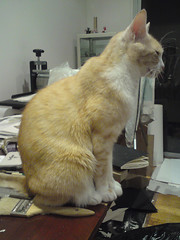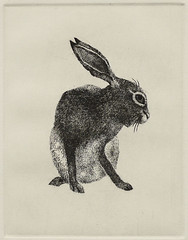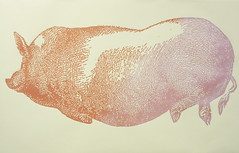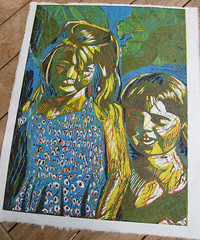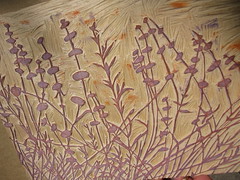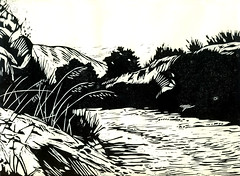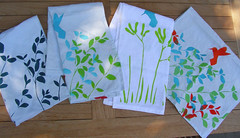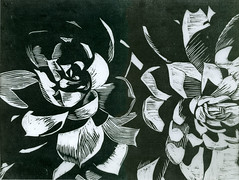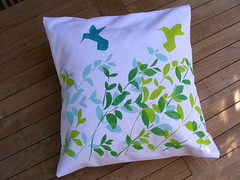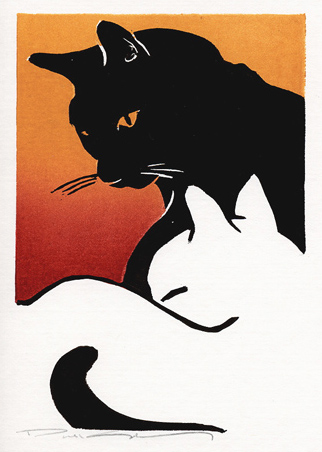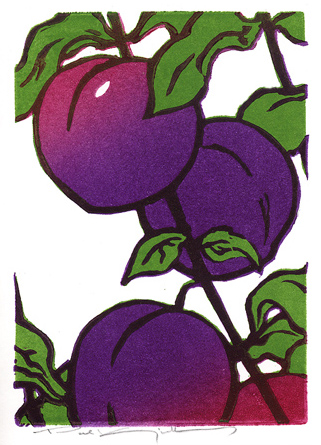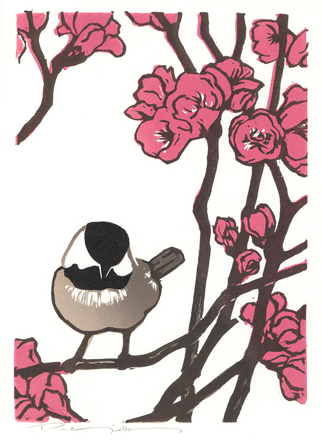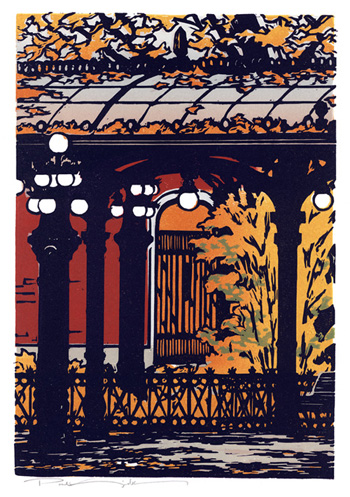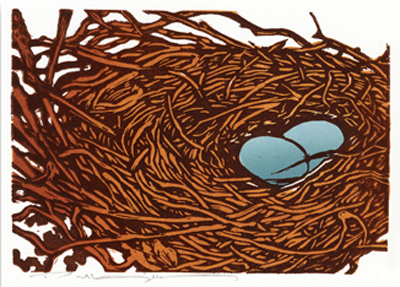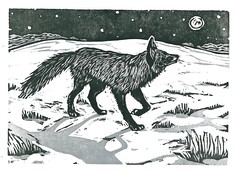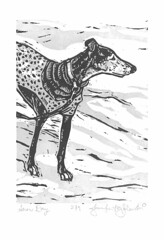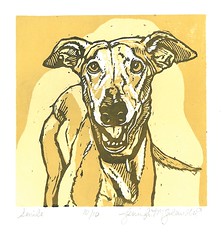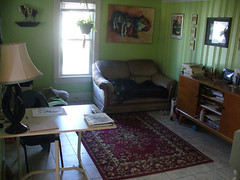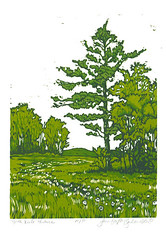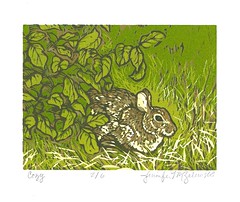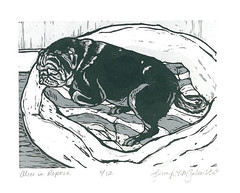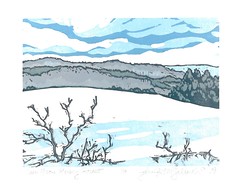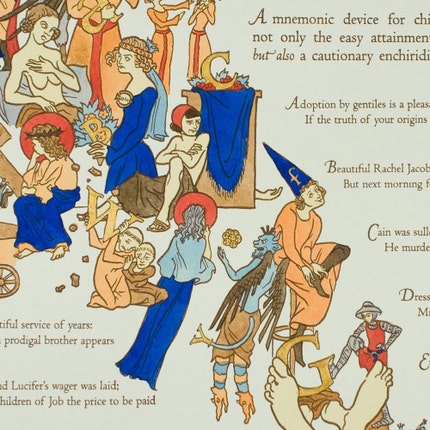
Name:
Chandler O'Leary -
Anagram Press
website: anagram-press.comblog: anagram-press.com/blogEtsy: anagrampress.etsy.comBio:When people ask me where I'm from it's hard to answer them in one sentence. I usually say that I'm originally from Massachusetts, because that feels closest to the truth (I spent a chunk of my childhood there, and my family is from that area), but really I'm either from everywhere or nowhere. I spent my entire life moving from place to place—first as the child of a military family, then on my own. I got my B.F.A. in Illustration from the Rhode Island School of Design (RISD), and spent my junior year in Rome, Italy. After that I lived in Minneapolis, MN for five years, and last year my husband and I moved to Tacoma, WA. I quit my graphic design job when we moved, and turned Anagram Press into a full-fledged business and a full-time career.
How did you get started in printmaking?I think I came to printmaking from several different directions at once. On the technical side, I actually worked in the prepress departments of a couple of commercial printing plants during college and shortly after. I learned a huge amount about preparing images and the technical aspects of printing—at the time they seemed like really dull jobs, but in hindsight I'm so glad I have that experience, because I think it really adds a layer of professionalism to my work, and having a deep understanding of the process has allowed me to teach it to others. Also, for the first five years of my career, on top of my artistic work, I worked full-time as a graphic designer in a small firm in Minneapolis. Unlike some larger design firms, we didn't have a stable of production designers to clean up our files for us, work with prepress issues, or attend press checks at commercial printers—we ourselves had to be responsible for every aspect of the work we did, and I'm so glad for it. As I started getting into letterpress printing, this production experience ended up being one of the most valuable things I ever learned, as letterpress is so exacting and complex.

On the artistic side, it was definitely a winding road: I dabbled in a few different printmaking techniques in high school, especially linocuts and serigraph. Even then I was interested in avoiding shortcuts and doing everything by hand (if there's one hallmark to my work now, I guess it's that I do things the hard way!); I made my own screen frames and always drew and blocked out the screen by hand with pencil and screen filler (in fact, on the rare occasions I create serigraphs now, I still do it this way). In college I did the occasional serigraph, but most of my attentions turned to illustration and narrative, typography and design, and the art of the book (binding, storytelling, structure, etc.). After I graduated, I was interviewing for that graphic design job in Minneapolis, and as part of my portfolio I showed some of the artist books I had made in college. My final interview was with the owner of the company, and he said, "Hmm, you make books, huh? Well, I'm on the board of this little book arts organization, and we're having a little opening tonight. You should stop by." Turned out that little organization was the Minnesota Center for Book Arts (MCBA), and the opening was the celebration of their annual Winter Book publication—an edition of fine-press books that are all printed and bound by hand. That moment was like some sort of revelation: suddenly I'd found a place where I could channel all these interests and experiences. I started taking bookbinding, typesetting and letterpress printing classes at MCBA, and by the time I left Minneapolis last year I had been Artist-in-Residence there, a member of their Artist Co-op, faculty member and teen artist mentor, and had worked on a couple of their Winter Books (as illustrator one year and part of the letterpress team the next). For the past few years I've been doing really technical and complex letterpress prints and artist books, mostly using the new technology of photopolymer plates—which brings together drawing, the old-fashioned hand-work of letterpress, and digital file production. I've recently gotten back into linoleum block printing, though, too. It's a chance to give myself an occasional break from all the really technical stuff and enjoy the physical process of carving.
Describe where you work.All of my drawing, computer work, and carving is done in my home studio, a room that was probably originally built as an in-home business of some sort, since it has its own entrance and can be closed off from the living room with French doors. In there I have my computer, storage cabinets, antique drafting table, another table for binding and large-scale work, a large antique flat file for storing artwork, and more books than I care to admit. I also have a very small, tabletop platen press that I use occasionally for small linocut prints. Most of my printing, however, is either done at the University of Puget Sound, where I am currently restoring a larger tabletop press for the University Library; or (for the more complex stuff) at
Springtide Press, the private studio of Jessica Spring, a friend and letterpress collaborator of mine.
I would love to hear about your time in Rome, and your experiences/background as an illustrator and how they've shaped your art.I spent my junior year of RISD in Rome; the college has a house there, just a few blocks from the Pantheon, that was built in 1590. Unlike my experience in the main Providence, RI campus, where everyone was basically expected to pour all of their effort into working, in Rome we were expected to channel our work through the experience of living. The house was set up for us to adapt to normal Italian domestic life (we had three big kitchens, for instance, and the studio portion was locked every night so we wouldn't be tempted to pull all-nighters working), and we were required to keep a sketchbook during our time there. I probably would have done that anyway, but for the first half of the year I spent basically every daylight hour out on the street, sketchbook in hand. I'm also interested in photography, but I forced myself almost never to bring my camera around with me, so that I'd have to draw if I wanted a record of something.

The result can be frustrating when you're traveling (I also spent a lot of time traveling around other parts of Italy) and don't have much time in a particular place, as you simply don't have time to see and draw everything. But I learned pretty quickly that when you're looking at the world through the lens of a camera all the time, you don't have much of a memory of the experience. When you spend that time drawing what you see, you're really, really looking. Because of my sketchbooks, my memories of Rome are probably the most vivid of my entire life—it's like I was there yesterday. That revelation about drawing is probably the most important thing I've ever learned, and I carry that with me through all of my illustration and printmaking work (which always, always begins with a drawing, very often from direct observation). I still keep a sketchbook in my bag at all times, and try to carve out as much time as possible for drawing outside, wherever I am.

The other thing about Rome that was so influential for me was the fact that I really fell in love with the art of the book there. I spent a couple of days in Siena (near Florence), and was absolutely floored when I saw the collection of illuminated manuscripts on display in the cathedral there. I wondered what it was like for the monks who made them to devote so many solitary hours to drawing, lettering, and binding. So I decided to make my own (because I'm nuts); I spent the second half of my time in Italy creating a one-of-a-kind, hand-lettered, hand-painted, hand-bound "illuminated manuscript" of my own. That book is now in the permanent collection of the University of Denver Library, so I don't have it in my life anymore, but it was really the gateway that pointed me down the path of artist books and letterpress printing that I'm on now.

Having that degree in illustration and the professional experience in graphic design has really shaped what I do, too. From the interest in letterforms and typography, to the level of technical expertise required in the sort of "digital letterpress" that I do, to the sense of composition and narrative that illustration taught me; all these things come together for me every day, and I could never separate my art from those roots.
What's your favourite printmaking process?I love linocuts because of how tactile the process is—there's something really satisfying about carving every line of one's drawing into the material. You really get to know your own drawing (which deepens your understanding of the subject, I think) when you have to flip it over and re-trace it backwards with a knife.
On the other hand, though, most of my letterpress prints involve a fairly new process using a material called photopolymer. This is probably the most direct way for me to turn a drawing of mine into a printed image; I start with a hand-inked line drawing, scan it in at high resolution, have film negatives made from the scan. Photopolymer plates are a light-sensitive plastic, which when exposed by a contact exposure with the negative and UV light, harden wherever the negative lets light through. Then the unexposed plastic is gently scrubbed away using a bristle brush and water; what's left is a relief plate. Photopolymer plates can hold an incredible amount of detail, and are very durable, so they're ideal for tricky registration and color work.
 What's your creative process for any given print? (eg. sketch first? Pre-planned or free-form?)
What's your creative process for any given print? (eg. sketch first? Pre-planned or free-form?)Well, I outlined most of the technical stuff above, but I always start with a drawing first. I really admire people who can do things like monoprints and free-form work with whatever medium they're using, because my brain just doesn't work that way. I'm pretty obsessive when it comes to planning; I have volumes and volumes of sketchbooks just devoted to things like diagrams and conceptual tinkering.
What do you enjoy most about printmaking?I love the idea of the multiple. When I'm drawing in my sketchbook, it's usually incredibly involved, with ink and watercolor, etc. All that work for one drawing. With printmaking, however, I love how each print is subtly different. I do a lot of hand-coloring with my prints (especially linocuts), so I can make each piece unique.
What's your least favorite part of the process?I'd say the hardest parts are the physical and financial strain. Linocuts are very economical to make, but carving is really hard on one's body—I have chronic repetitive-motion injuries, and I'm still in my twenties, so I've learned to be really careful. (I'm planning to be doing this when I'm ninety, so I need to make sure I'm still capable of it!) Working with photopolymer plates, on the other hand, is far less physical, but the materials are prohibitively expensive. I have to be careful to promote the work well so it'll sell (so I can justify the cost of the materials), or else find funding for a project. I just got a grant for my next artist book, though, so that takes a lot of the pressure off. It seems like I spend a lot of my time applying for funding, though, rather than actually making prints—so maybe that's my least favorite part of the process!
What are your inspirations (other artists, people, places, events, etc.)?This is always a hard question for me to answer, because my inspirations come from so many places that it's hard to go back and trace them individually. My classmates at RISD were always a huge inspiration to me, and I'm still in touch with many of them now—they've all turned out to be incredible artists, and I learn so much from them still. My favorite social activity is just talking shop with my artist friends; many of my best projects began as a conversation I had with a fellow artist. I also have a huge reference library that I've been building since I was a kid—knowing one's history and artistic influences is really important, I think. A lot of my work references historical graphic design, so I'm always eager to read a treatise or artist biography, or to study the work of an artist him or herself. Finally, sketching is huge. I'm always drawing, always observing, always looking when there isn't time to draw. The vast majority of what I do is based on direct observation from life—so that pencil is always ready.
 How has your work changed and evolved since you started?
How has your work changed and evolved since you started?When I was in school people were always telling me to loosen up, to scribble more, to smear my charcoal, etc. Instead, over the years my work has gotten tighter and tighter, and I'm happy with that direction. Precision is a really big deal for me, especially since my work deals with hand-drawn patterns and lettering. I want to get as close as I can to perfection, and probably the most satisfying thing I've ever heard was "You drew that?" When the Industrial Revolution came about and most goods became mass-produced, the products deemed to be of the highest quality were those that look like they were handmade. Now it seems like it's the opposite: it's a very high compliment now to be told that your work looks like it was done by a machine. That's a really weird thought for me, but I think it's true. So I guess my mission in life is to bring handwork back to a revered status, to prove to people that perfection and precision can be obtained simply by using one's hands.
How do you get past creative slumps?That's a big pitfall for me, probably because of all the crazy perfectionism. The biggest way I get around it is always to have a deadline and a "next thing." I get in the habit of telling people about what I'm working on, and making sure I mention when they can expect to see the finished product. It forces me to finish it, even if I never meet my own ridiculous expectations. Also, if there's always another project that I want to start, the sooner I finish what I'm currently working on, the sooner I can get going on the next thing. I can't say I've ever had a time where I didn't have an idea, and I think I'm fortunate there. The problem is finding enough hours in the day to do everything I want to do, and getting past too-high expectations for quality that make me put things off.
How do you promote your work?This has been a huge challenge, and kind of a trial-by fire lately. When I moved to Washington I quit my full-time graphic design job and decided to make my art my career. When you have to make a living from your art, you learn pretty quickly to get your name out there. Like I said above, I spend a lot of time (a frustrating amount) applying for grants, freelance gigs and other opportunities—it's just part and parcel of the work, but only a small percentage of it gets me anywhere. I think the biggest thing anyone can do is just let the world know you exist, and that you're making work. So I designed a website, started a blog, printed postcards that I give to anyone and everyone. It's especially important considering that I just started over in a new city 1800 miles away from where I lived before. So far, so good—knock on wood. Plus, it's just so important to keep creating work. When I'm in the middle of things, it can seem frustrating, like I'm not doing as much as I'd like to do. But when I look back at everything I've managed to do in the past month, or year, or few years, I'm always pleasantly surprised. A printer I greatly admire is always telling me, "Just do the work, the rest will follow." That's so true.
Any other comments or advice for others who want to try making hand-pulled prints?First off, take care of yourself. We're not brains on sticks—in order to keep the ideas flowing we have to keep our bodies healthy. So get some sleep (my motto at RISD used to be "I'll sleep when I'm dead," but that's a really dumb idea, it turns out), eat healthy food, and take care of those hands. Printmaking is very physical work, and it's easy to do long-term damage. If you take care of yourself and work at a reasonable pace, your body will be around for a lot more printmaking.
Also, the person who taught me letterpress printing has this great saying that I repeat to everyone: "There is no such thing as a good first impression in printmaking." I love that. Don't be afraid to keep fiddling with your image, your press, your impression, etc. until you get the results you're happy with. It might take a lot of time to achieve what you're looking for, but it'll come. It always does.
Thanks very much, Chandler, for the great interview!
 Etsy: kyokoimazu.etsy.com, rachelscabinet.etsy.com
Etsy: kyokoimazu.etsy.com, rachelscabinet.etsy.com
